Time Management Systems: All You Need to Know
If you’re like most people, time seems to slip through your fingers, no matter how well you think you’ve planned your day.
There’s always one more email to reply to, one more task to finish, or another project waiting to be squeezed in, and you’re constantly scrambling.
The thing is, it’s not just about your workload—it’s about how you’re managing your time. That’s where time management systems come in. Let’s dive right in!
What are time management systems?
Time management systems are structured frameworks designed to help you plan, prioritize, and track your time effectively.
Don’t worry – we’re not talking about over-complicated processes that leave you feeling like you need a PhD in time management just to get started. These are practical, proven systems that anyone can implement to regain control of their day.
Time management systems can include a simple to-do list, a grid or calendar format, and a method for prioritizing tasks for working hours. More complex time management systems are automatic time-tracking apps, task management software and different types of planners.
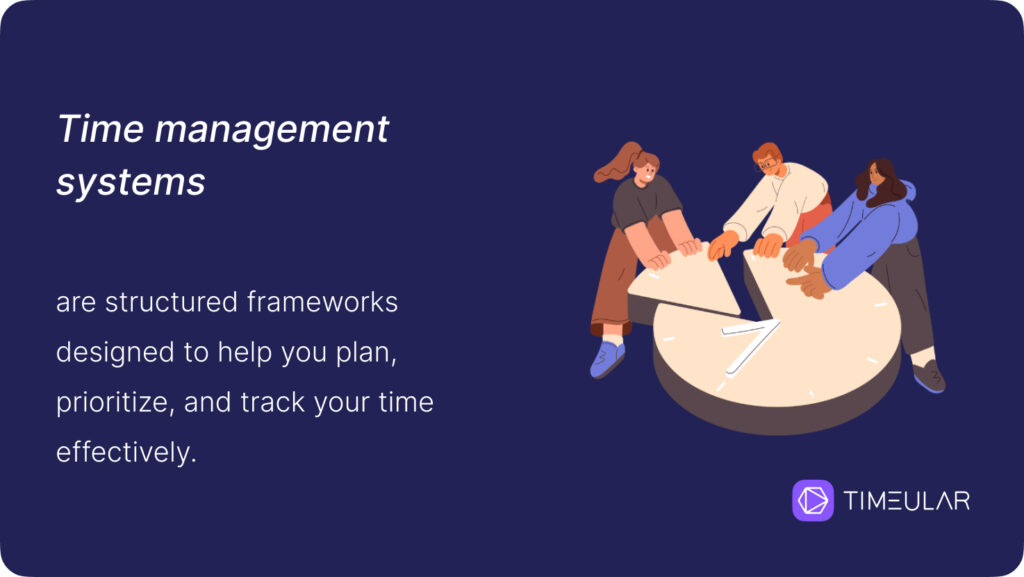
Think of them as a way to get your tasks, projects, and even your downtime in sync so you can have more mental capacity and focus on what really matters. When using a time management system, you stop reacting to your tasks and start acting intentionally.
Did you know that 82% of people don’t have a time management system? That’s just one of the many staggering time management statistics that still amaze me.
Why do you need a system (not just a plan)
Without a system, your day can feel like a never-ending game of catch-up.
You might set work goals and make to-do lists, but if you’re constantly interrupted or find yourself switching from one task to the next without progress, you’re not managing your time. You’re just putting out fires. A good time management system helps you see the bigger picture while also giving you tools to dive into the details. You’ll know what to focus on, what to delegate, and, importantly, when to say no.
Do you know how to say no at work? Remember, saying no doesn’t make you a bad employee. It rather makes you an organized, respectable employee and team member.
Implementing time management systems equates with having time management skills, which are pivotal both for personal productivity and work-related projects.
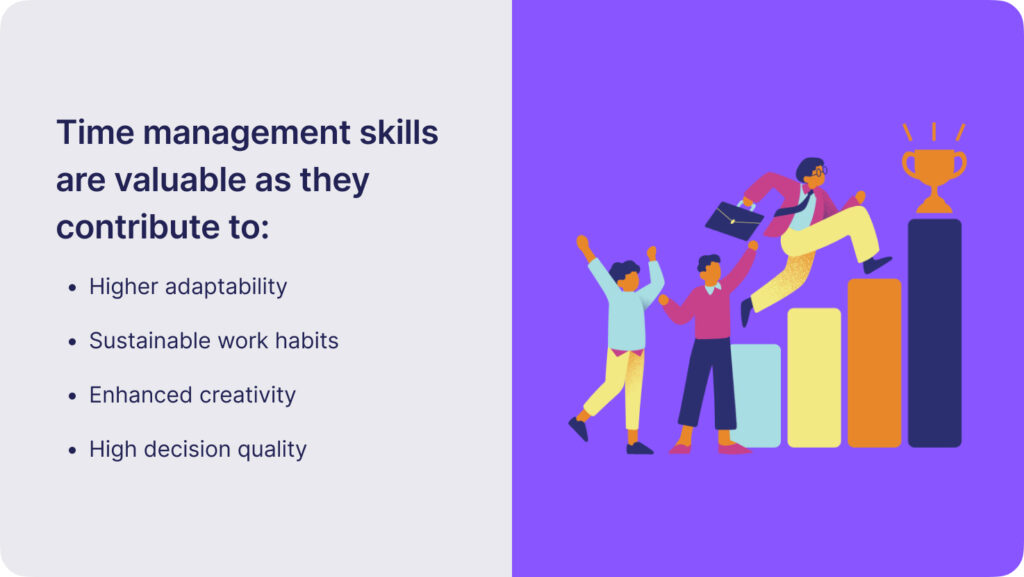
Popular time management systems that work
Here’s a breakdown of a few time management systems you can consider:
1. The Eisenhower Matrix
You must have felt like every task at work was urgent many times now. The multiple projects you’ve managed with tight deadlines or the pressing demands from your clients to integrate their new feedback should have hampered your ability to assess how to prioritize tasks.
That’s where the Eisenhower Matrix comes in. It helps you create tasks and prioritize them based on their urgency and importance.
This system categorizes tasks into four quadrants:
Do first: Urgent and important tasks (think of this as the fire-fighting mode).
Schedule: Important but not urgent (the long-term important projects that will help you grow).
Delegate: Urgent but not important (tasks that can be handled by someone else in your team/department).
Delete: Neither urgent nor important (yes, these exist—and yes, they’re time wasters, so they need to be completely eliminated).

The Eisenhower Matrix is also called the Time Management Matrix. Former President Dwight D. Eisenhower used this method to navigate massive crises, including WWII planning, without getting overwhelmed by urgent distractions.
If Eisenhower could focus on what truly mattered during that chaos, imagine how you could apply this system to your day-to-day work and how effectively you’d manage your workload.
2. The Pomodoro technique
This technique is perfect if you struggle to stay focused for long periods of time. It’s simple:
Set a timer for 25 minutes or track time for 25 minutes while you stay focused on a task (a “Pomodoro”);
Then, take a 5-minute break and restart the cycle;
After four Pomodoros, give yourself a longer break.
The beauty of this system lies in its simplicity. You might think that working in short bursts wouldn’t lead to much, but you’d be surprised. I’ve experimented with this technique on multiple tasks, and regardless of the complexity of a task, it forced me to stay focused only on one task at a time and progress with it.
The Pomodoro Technique, especially when handling tedious, focus-heavy tasks like budgeting or detailed research for writing, is incredibly effective. It helps you ditch multitasking, which is proven to be ineffective, and the best part is that it makes managing tasks much easier.
If you’d like to try an online Pomodoro tracker, try our free Pomodoro timer.
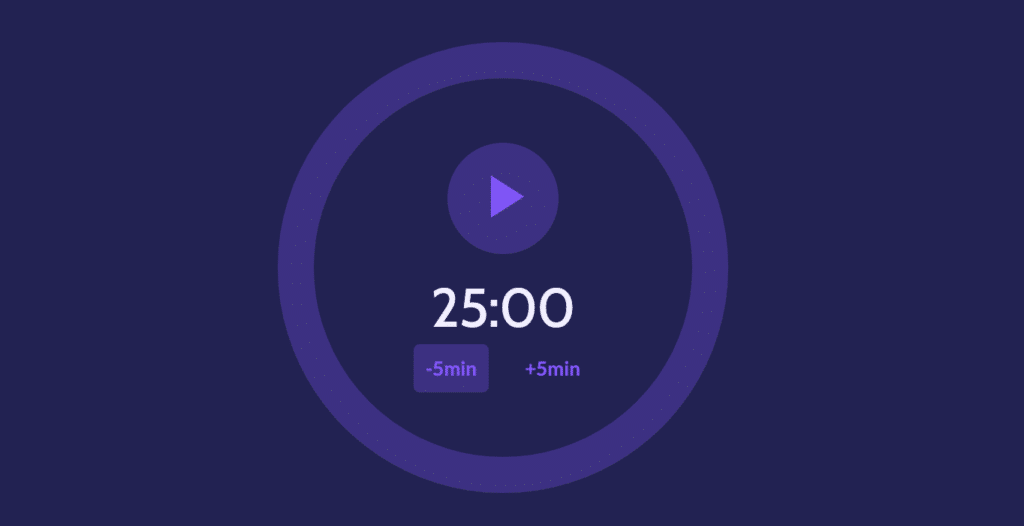
3. Time blocking
Time blocking involves setting aside specific blocks of time for specific activities. Instead of just adding tasks to a to-do list, you actually reserve time for them in your calendar. Want to spend two hours on deep work? Block it off in your schedule. Need time to answer emails? That gets its own block.
For example, Matilde, our Growth Manager, religiously uses time blocking. Between her roles as a data specialist, campaign strategist, and first-time mom, time blocking keeps her priorities clear and ensures she’s always on top of things without burning out.
You can deep-dive into our comprehensive article with the entire process of time-blocking.
Time blocking itself comprises many methods for protecting and tracking time for work. All methods below are linked in the time-blocking article mentioned.
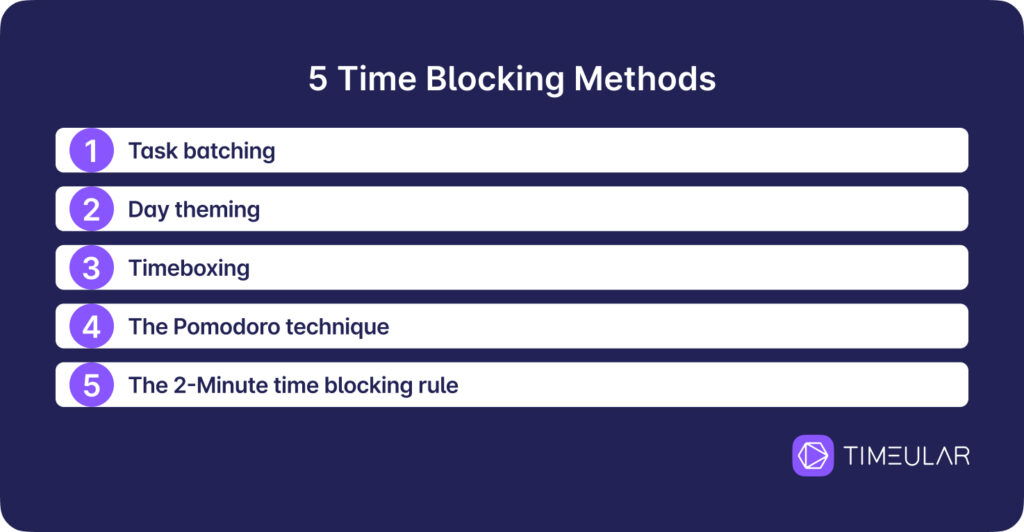
4. The 80/20 rule (Pareto Principle)
The Pareto Principle states that 80% of your outcomes come from 20% of your efforts. Applying this to time management means focusing on the few tasks that will give you the most results. It’s not about doing more but doing better.
For example, if you have ten tasks, only two might be crucial for advancing a project or hitting a deadline. The other eight might just fill up your day without moving the needle. Focus on those two, and you’ll see how quickly your productivity skyrockets.
This time management method is excellent for professionals who feel bogged down by endless to-do lists but rarely see real progress. Try applying the 80/20 rule to your weekly planning, identifying the most impactful tasks, and giving them your best time and energy.
Did you know that managing your energy might be one of the best time management systems? It’s one of the time management strategies used by Tony Robbins.
5. The Getting Things Done (GTD) Method
Created by David Allen, the GTD system focuses on capturing all your tasks and ideas in one place, then processing them in a way that frees up mental space. It’s a powerful way to get everything out of your head and into an organized system.
The GTD method has five steps:
Capture: Write down everything you need to do.
Clarify: Decide if it’s actionable, and if so, what the next step is.
Organize: Put tasks into lists or calendars based on priority.
Reflect: Review your lists and calendars regularly.
Engage: Get to work.
GTD is especially helpful if you’re someone who constantly feels like they have way too many ideas floating around but never enough focus to get things done. GTD is particularly useful, too, if you’re creative or juggle multiple clients with complex projects at the same time.

6. A Kanban system
Kanban is a visual time management system you might already be familiar with. You can use physical boards (post-it notes) or digital tools like Trello.
The most well-known Kanban board is Trello, a project management software with a user-friendly interface in the form of cards.
Kanban involves organizing tasks into three categories:
- To do
- In progress
- Done
Each task gets its own card or note, and you move them across the board as they progress. This system is perfect for visual learners and those who like seeing tasks physically move from one phase to another.
Kanban is also great for teams and individuals alike, helping you visualize project progress and maintain focus on what’s actively being worked on. It’s also a quick way to spot bottlenecks, so when a task gets stuck in the “In Progress” column, you know where the problem is.
You might be interested in Trello time-tracking.

7. The “Eat the Frog” method
One of the most popular time management strategies out there is the “Eat the Frog” method.
Even if it’s not one of anyone’s preferred methods, it helps you reach a level of stress-free productivity. Let me explain: It’s all about tackling your biggest, most challenging, or least enjoyable task first thing in the morning.
The idea is simple: your most dreaded task is the “frog,” and by dealing with it head-on at the start of the day, you set yourself up for success. Once that heavy lift is out of the way, everything else feels easier, and you avoid a cycle of procrastination.
Personally, I have to admit this isn’t my go-to strategy. I tend to hit my stride later in the day when my energy kicks in. But my colleague, Karolina, swears by it. She says:
“My favorite time management strategy? Start the day or week with the least pleasant task. This technique, called ‘eat the frog,’ ensures I complete all my to-do list tasks, not just the ones I find interesting.”
– Karolina Matyska, Senior Content Marketer
So, if you’re the type who thrives on knocking out tough tasks early, here’s how you can make the “Eat the Frog” method work for you:
Identify the “Frog” – Pick out the most critical or daunting task you need to complete for the day. This is the one that, if done, will give you the biggest sense of relief and fuel to continue with your work.
Do it first – Tackle this task before anything else. No checking emails, no quick wins with easier tasks. Just dive in.
Avoid procrastination – The key to this method is discipline. Resist the temptation to push the difficult task aside in favor of easier ones.
Celebrate your win – Once that task is done, take a moment to appreciate the progress you’ve made. This momentum can carry you through the rest of your day with a sense of achievement.
While it might not be for everyone, “eating the frog” is the first thing that can be a powerful way to gain control of your day and feel productive right from the start.
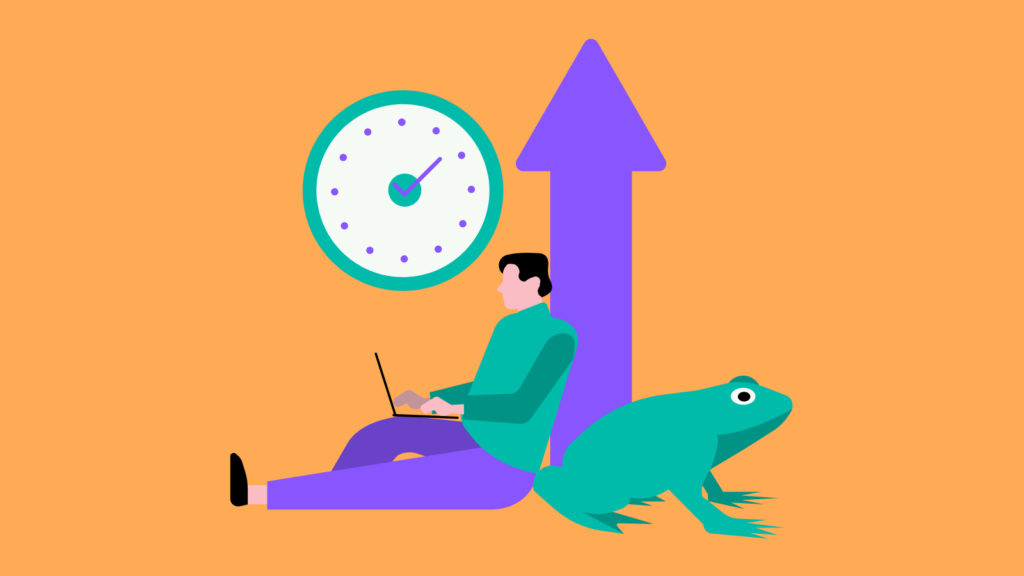
8. The 1-3-5 rule
The 1-3-5 Rule offers a refreshing way to tackle your day without feeling overwhelmed. The idea is simple: You focus on 1 big task, 3 medium tasks, and 5 small tasks every day.
Why does this work? It creates a sense of balance between tackling high-priority projects and handling the smaller, repetitive tasks that also need attention. You won’t end the day feeling like you left too much undone, but you also won’t get stuck just doing the easy stuff.
For example, your big task might be drafting a presentation. Your medium tasks could include research, reviewing documents, and scheduling meetings. The small tasks might be answering emails, filing paperwork, or checking in with your team.
By the end of the day, you’ll have made meaningful progress on big-ticket items while also keeping smaller assigned tasks in check.
9. The ABCDE Method
If prioritizing tasks feels overwhelming, the ABCDE Method developed by Brian Tracy offers a simple but effective approach. Here’s how it works:
A tasks: Must be done today, a top priority.
B tasks: Should be done, but not critical if delayed.
C tasks: Nice to do, but no real consequences if left undone.
D tasks: Delegate to someone else.
E tasks: Eliminate altogether.
This method forces you to confront the reality that not everything on your list is equally important. Once you’ve categorized your tasks, focus on your “A” tasks first. Don’t even think about touching a “C” task until the more critical ones are complete.
This system gives you a clear, straightforward way to prioritize specific tasks without getting lost in the noise of your day and understand task dependencies, too.

Add tools to your system: Time-tracking apps
While adopting time management systems is a great start, your productivity can skyrocket when you combine it with the right tools.
This is where time-tracking apps come in handy.
Timeular, for instance, is more than just a simple time-tracking app. It’s a time-tracking software that can help you track your time, identify patterns, and even pinpoint where you might be wasting valuable hours. Plus, it gives you an objective report, so the next time your boss or client asks why you couldn’t take on another project, you can back it up with data.

“We have become 20% more profitable because everyone is in the habit of time tracking.” – Richard Wingfield, Head Geek at Envision Design
Here’s how the best time-tracking software can enhance your time management:
Track work hours: Log your daily hours automatically with automated time-tracking features to know exactly where your time is going.
Monitor tasks: Get a detailed breakdown with time tracking data of how much time is spent on individual tasks or projects.
Receive AI-generated time suggestions: Receive AI-generated time entry suggestions based on your calendar events and past entries so you don’t forget to fill out your timesheet and can maintain a realistic overview of your daily tasks.
Capture billable hours: For freelancers or agencies, keep track of billable hours to ensure accurate client invoicing.
Identify time wasters: Spot unproductive time or tasks that are dragging down your efficiency.
Create detailed reports: Generate reports that provide insights into your time usage and productivity patterns simply by utilizing a time reporting system.
Manage time off and overtime: It’s not just about work time. A time-tracking tool helps you manage your team’s time off, track overtime, and balance everything.
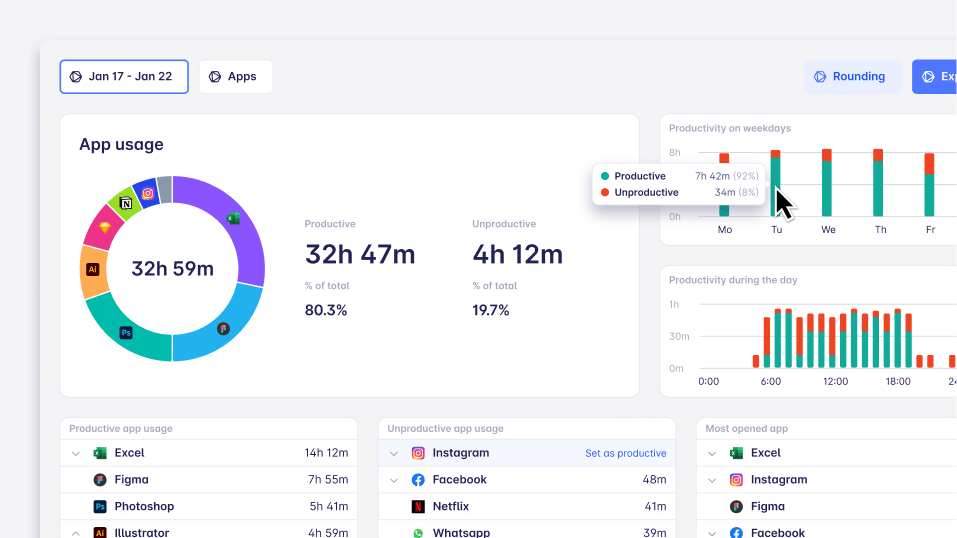
If you’re looking for the best time-tracking tools, we have a collection of articles on this topic:
Note that the time tracker might not include project management features, but you will definitely find features such as unlimited users. You’ll be able to assign tasks and track tasks for unlimited projects at the same time.

Powered by AI and supercharged with easy-to-use methods, Timeular helps you track time in < 1 minute a day.
The bottom line
Mastering time management goes beyond just improving workplace productivity. It enables you to create more space for what truly matters in life, whether that’s spending time with family, pursuing personal passions, or simply maintaining a healthy work-life balance.
Implementing a structured time management system, supported by a reliable time-tracking tool, can significantly reduce overwhelm, prevent burnout, and enhance your sense of control over your daily responsibilities.
While no system will eliminate all challenges, adopting the right approach empowers you to navigate your workload more effectively, ensuring you achieve both your professional and personal goals. Now is the time to explore and implement a system that works for you. ]Once you do, the benefits will be clear—not only in your increased productivity but in the balance and fulfillment you’ll gain in both work and life.
FAQ
What are the 4 types of time management?
The four types of time management are time-based, task-based, energy-based, and priority-based. Using a time management tool like a free time tracking app helps track how many hours you spend on the same task, improving workload management and maintaining work-life balance.
What are time management systems?
Time management systems are structured methods for organizing tasks. They combine workload management with tools like web apps or app tracking to boost employee productivity. Project managers use these to avoid busy work and improve team performance.
What are the 4 P’s of time management?
The 4 P’s of time management are Planning, Prioritization, Performance, and Procrastination Management. These principles guide how you organize tasks, focus on priorities, optimize productivity, and minimize delays.